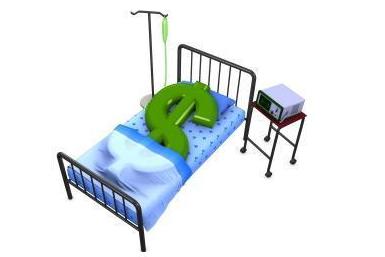 Anyone facing a critical illness, such as cancer, a heart attack or a stroke, has to deal with more than just a physical and mental struggle—it can have a tremendous financial impact as well. Even those with health insurance can take a hit from co-pays, lost income, lifestyle changes and items not covered by their provider.
Anyone facing a critical illness, such as cancer, a heart attack or a stroke, has to deal with more than just a physical and mental struggle—it can have a tremendous financial impact as well. Even those with health insurance can take a hit from co-pays, lost income, lifestyle changes and items not covered by their provider.
A 2009 study by Harvard University found that 62 percent of all bankruptcies in the U.S. were the result of medical bills. Researchers found that 78 percent of these people had health insurance when they first became sick.
While some people lost their jobs and health insurance because they were too sick to work, the study found that most medical bankruptcies were from those who maintained their medical coverage but deductibles, loopholes and co-pays became too great a burden.
Critical illness insurance has been around since the mid 1990s in the U.S., although it’s still just catching on. Plans differ among providers but they generally provide a lump-sum cash payment in case of a serious illness, with all plans covering the big three: cancer, heart attack and stroke. It’s designed as a way to fill any gaps in health insurance and reduce or eliminate the financial stress of getting sick.
“It’s an empowerment product, by that I mean it empowers the consumer who owns this product to use this lump sum of money any way they deem fit. That can be to help pay medical bills, it could be also that a person needs to fund education expenses for their kid, so they’re not neglected, or they want a vacation,” says Dan Pisetsky, president of U.S. Living Benefits and vice president of public relations for the National Association for Critical Illness Insurance.
Even for those with health insurance, getting sick doesn’t come cheap. A 2009 study by the American Cancer Society and Georgetown University’s Health Policy Institute analyzed the costs of major illnesses for those in the Federal Employee Health Benefit Package, the largest group insurance market the country.
According to the study, someone with Stage 2 breast cancer would pay $10,096 in deductibles, coinsurance and co-pays for all in-network services, a figure that would obviously increase if non-preferred providers were used. Out of pocket expenses for a heart attack were $5,014 for in-network services.
“Your health insurance doesn’t pay everything and, more importantly, your health insurance, when you have a dreaded disease like cancer or heart attack or stroke your life changes,” says Jesse Slome, executive director of the American Association for Critical Illness Insurance. “You want to for a period of time, it might be six months it might be a year, it might be two years, not have to worry about how you’re going to pay for your living. You want to focus on getting healthy, not moving back in with mom.”
Ed Mueller, co-owner of Life & Health Benefits Solutions LLC and co-author of three books on critical illness insurance, notes that it’s common for a family member to take time off from work when there’s an illness. If a wife or husband has to stay home and take care of their spouse it creates an even greater financial strain.
Someone might also opt to seek treatment at a hospital outside of their insurance provider’s network, which would result in higher out-of-pocket costs, or have travel and other expenses.
Slome says a friend of his flew across the country and had to stay in a hotel for a liver transplant. His friend was fortunate to have sufficient health insurance to pay for this, but most people don’t have that level of coverage.
Considering the options
Perhaps the number one alternative to critical illness insurance is the better-known disability insurance, which pays 60 percent of someone’s income if they’re unable to work. With disability insurance claimants typically have a waiting period before receiving a series of payments. Critical illness insurance, on the other hand, is paid in full as soon as a diagnosis is made.
“I like lump sum. If I’m diagnosed, give me the money now so I don’t have to be concerned about where the money is coming from or where’s that check from the disability.” Mueller says. “You don’t want to be thinking about that, you’ve got to go through chemo or you’ve got to recover, so peace of mind is another very large intangible that comes along with getting a check for $30,000 or $50,000.”
 In addition to covering the big three diseases of cancer, heart and stroke many policies also include renal failure, organ transplants and paralysis. From there a policy might include any number of critical illnesses that, while severe, are less likely to strike.
In addition to covering the big three diseases of cancer, heart and stroke many policies also include renal failure, organ transplants and paralysis. From there a policy might include any number of critical illnesses that, while severe, are less likely to strike.
Rather than focusing on a long list of possible illnesses, Pisetsky says he prefers a loss of independent existence, which is offered under some critical illness plans. It provides payment for activities of daily living, such as dressing, bathing and using the toilet and can serve as an alternative to long-term care insurance.
Although he’s a supporter of critical illness insurance plans, Pisetsky says they’re not for everyone. He himself became involved in this area while in his 50s and had a choice between critical illness and long-term care insurance. Pisetsky went with long-term care as part of his retirement planning, which at that point in his life was a better value.
“I do not want people to think that critical illness is a panacea for all health care. It’s an arrow in your quiver and you’ve got to figure out how best it fits into your overall planning,” Pisetsky says. “I think the older you get maybe there are alternatives to look at and that being long-term care.”
When to buy
The optimum age for someone to consider critical illness insurance is by the time they reach their 40s, as buying a policy later in life can become prohibitively expensive or result in a lower level of coverage.
Mueller says someone should buy critical illness insurance as soon as they can afford it, as he once sold a policy to a 28-year-old who developed throat cancer six months later. At a premium of $25 per month, Mueller says a 30-year-old could get around $25,000 in coverage and obtain a level of coverage at a rate that might not be available later on.
“They always have a caveat in their policy that they can raise the rates. I’ve had a policy since 1993, a heart attack policy that I bought for $27 per month, $25,000 worth of coverage and the premium has not gone up one penny since 1993 and I still have the coverage,” Mueller says.
While $25,000 is a typical level of coverage larger amounts are available, up to the six-figure range, although this would require a medical exam and a consideration of medical history. Mueller says no exam policies are typically available for up to $70,000 in coverage.
Types of plans
Although the general idea of critical illness insurance is a one lump payment, there are actually a few variations of these policies:
The one lump payment— the policy pays in full one time for a designated critical illness. Any additional illnesses after that would require another policy.
A three-category plan—would pay a lump sum amount within each category such as one payment for a heart attack, one payment for cancer etc. Although this plan would pay three different times, it would not cover more than one illness in each category (such as two heart attacks).
Life with living benefits—a combination of life insurance and critical illness. For example, a $200,000 policy would pay in full as a life insurance policy when a person dies. A person could also tap into the policy for up to 90 percent of its value, in case of a critical illness, and draw from that $200,000 value.
Indemnity policies—they pay a certain amount per each treatment received, such as $200 for each chemotherapy treatment. It provides a continuous coverage as long as the policy is maintained.
Another option, one that is gaining in popularity, is a return of premium plan. The downside is these plans are more expensive, although if no claim is made on them 100 percent of the premiums are returned to the policyholder’s estate after they die, or to the policyholder themselves after a set period of time.
“How can you not do this when you’re guaranteed your money back, every penny of it back?” Mueller says. “If you don’t file a claim you’re going to get all your premiums back, less the claims that they’ve paid so it’s a great savings account and you have this coverage in case something happens to you.”
Slome, on the other hand, says return of premium plans aren’t worth their higher cost because the policyholder is essentially giving an interest-free loan to the insurance company.
“You’re basically paying to get your money back and you’re paying a high premium because they know if you want that privilege are going to be willing to pay for it and they’ll charge you whatever they darn well please,” Slome says.
As for the right level of insurance, Pisetsky says a year’s worth of income is a typical benchmark, although someone who owned their own business might need a higher level of coverage to help keep it running while they recover. Mueller suggests insuring for six months worth of bills, plus any potential health insurance deductibles and co-pays.
Of course, policies can differ so it’s important for anyone considering critical illness insurance to make sure they fully understand what’s covered and what the policy actually says.












